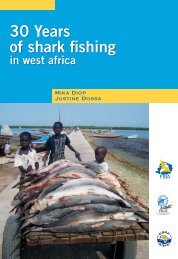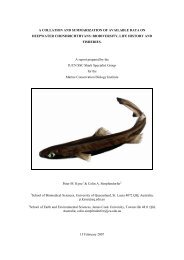Magazine of the species survival Commission specialist Group - IUCN
Magazine of the species survival Commission specialist Group - IUCN
Magazine of the species survival Commission specialist Group - IUCN
Create successful ePaper yourself
Turn your PDF publications into a flip-book with our unique Google optimized e-Paper software.
editorial<br />
resources at all levels, from national to international, and from<br />
all sources, both public and private.<br />
Clearly, increasing investment in biodiversity conservation<br />
is not going to be easy in <strong>the</strong> current economic climate.<br />
However, <strong>the</strong> findings <strong>of</strong> The Economics <strong>of</strong> Ecosystems and<br />
Biodiversity (TEEB) study are particularly relevant here. This<br />
study draws toge<strong>the</strong>r considerable knowledge and scientific<br />
expertise to evaluate <strong>the</strong> impacts <strong>of</strong> biodiversity loss, <strong>the</strong><br />
costs and benefits <strong>of</strong> conservation, and <strong>the</strong> efficiency <strong>of</strong><br />
instruments and actions to reduce biodiversity loss. The<br />
TEEB study tells us that conserving biodiversity can generate<br />
large economic returns, while also <strong>of</strong>fering a cost-effective<br />
means to mitigate and adapt to climate change and o<strong>the</strong>r<br />
natural disasters. TEEB also demonstrates how integrating<br />
biodiversity in <strong>the</strong> economy and reforming public policies to<br />
reflect ecosystem values can help reduce public expenditure,<br />
while stimulating significant private investment in biodiversity<br />
conservation and ecosystem services.<br />
The implementation <strong>of</strong> <strong>the</strong> Strategic Plan needs to involve<br />
actors in both <strong>the</strong> public and private sectors. Proven financial<br />
mechanisms and incentives, documented in <strong>the</strong> TEEB study,<br />
need to be streng<strong>the</strong>ned and implemented more widely, such<br />
as payments for ecosystem services, biodiversity <strong>of</strong>fsets, and<br />
eco-labelling schemes. <strong>IUCN</strong> is calling on countries to<br />
urgently implement <strong>the</strong>se and o<strong>the</strong>r incentive mechanisms<br />
which can mobilize new and additional investments in<br />
biodiversity conservation and restoration. Particular priority<br />
should be given to mechanisms that can stimulate<br />
international financial flows from <strong>the</strong> private sector to support<br />
biodiversity conservation, such as REDD+ schemes and <strong>the</strong><br />
Green Development Mechanism, amongst o<strong>the</strong>rs.<br />
At <strong>the</strong> same time, <strong>IUCN</strong> is calling on governments to<br />
redouble <strong>the</strong>ir efforts to reduce or reform environmentally<br />
harmful subsidies, in order to discourage damaging activities<br />
and free up public resources for more productive uses. For<br />
example, subsidies to industrial fishing, intensive agriculture<br />
and fossil energy amount to over USD 500 billion a year in<br />
OECD countries. Reforming <strong>the</strong>se and o<strong>the</strong>r public subsidies<br />
can make a significant contribution to biodiversity<br />
conservation by reducing <strong>the</strong> incentives for destructive<br />
activities. In addition, if a proportion <strong>of</strong> <strong>the</strong> ‘savings’ achieved<br />
were re-directed to biodiversity conservation and restoration,<br />
it would represent a significant increase in <strong>the</strong> resources<br />
available to implement <strong>the</strong> CBD Strategic Plan.<br />
We believe that much is at stake at <strong>the</strong> current CBD<br />
negotiations and that <strong>the</strong> risks <strong>of</strong> failure are significant. We are<br />
doing all we can to encourage governments to seize <strong>the</strong><br />
moment, and to commit to an ambitious financial target in<br />
Nagoya. It is important to remember that <strong>the</strong> excellent work<br />
that you do in <strong>the</strong> Specialist <strong>Group</strong>s, contributing to <strong>the</strong> <strong>IUCN</strong><br />
Red List and o<strong>the</strong>r SSC projects, all builds up and contributes<br />
to <strong>the</strong> global negotiations that are now taking place. It is no<br />
exaggeration to say that <strong>IUCN</strong> has been able to have a<br />
significant voice and impact in <strong>the</strong> development <strong>of</strong> <strong>the</strong> CBD<br />
Strategic Plan, in large part because <strong>of</strong> <strong>the</strong> collective work <strong>of</strong><br />
all <strong>the</strong> members <strong>of</strong> <strong>the</strong> SSC. Let us hope that this will result in<br />
a major new conservation agenda emerging from Nagoya, in<br />
which governments will give much higher priority to<br />
biodiversity conservation. If this is <strong>the</strong> case, <strong>the</strong>n <strong>the</strong><br />
International Year <strong>of</strong> Biodiversity (IYB) in 2010 will be shown to<br />
have been more than just a branding gimmick with a nice logo.<br />
Species <strong>of</strong> <strong>the</strong> Day. As most SSC members will know, one<br />
particular contribution to raising <strong>the</strong> pr<strong>of</strong>ile <strong>of</strong> <strong>the</strong> IYB is<br />
Species <strong>of</strong> <strong>the</strong> Day. We would like to thank <strong>the</strong> hundreds <strong>of</strong><br />
SSC members who have contributed to this already. Ensuring<br />
that we have a new, complete <strong>species</strong> account for every day<br />
<strong>of</strong> <strong>the</strong> year, with its text reviewed by <strong>the</strong> appropriate SSC<br />
members, toge<strong>the</strong>r with a photograph and a map, is no small<br />
logistical task. In our last Message, we reported on <strong>the</strong><br />
amazing variety <strong>of</strong> <strong>species</strong> covered. Of course it is even more<br />
impressive now. Surely no scientific network o<strong>the</strong>r than <strong>the</strong><br />
SSC could produce <strong>species</strong> accounts covering <strong>the</strong> following<br />
extraordinarily diverse array <strong>of</strong> taxonomic groups: lichens,<br />
cup fungi, liverworts, mosses, seagrasses, columbines,<br />
conifers, cycads, oaks, baobabs, legumes, palms, proteas,<br />
cinnamon, rock-roses, marigolds, orchids, hea<strong>the</strong>rs,<br />
mangroves, mahoganies, water-lilies, magnolias, cacti,<br />
corals, mussels, abalones, snails, butterflies, dragonflies,<br />
damselflies, grasshoppers, stick-insects, katydids, crickets,<br />
wetas, crabs, spiders, millipedes, sharks, skates, stingrays,<br />
sawfish, coelacanths, sturgeon, eels, groupers, wrasses,<br />
blennies, catfish, salmon, seahorses, cardinal fish, barbs,<br />
frogs, salamanders, crocodiles, turtles, tortoises, snakes,<br />
skinks, geckos, iguanas, parrots, albatrosses, francolins,<br />
nightjars, hummingbirds, vultures, sandpipers, doves, terns,<br />
coursers, ibises, bustards, ducks, eagles, plovers, larks,<br />
mockingbirds, shrikes, finches, flycatchers, woodpeckers,<br />
bears, elephants, rabbits, jumping rats, rhinos, bats, whales,<br />
tapirs, pigs, bison, cats, monkeys, seals, hyaenas, cattle,<br />
goats, hippos, dolphins, anteaters, canids, lemurs, equids,<br />
marmots, deer, desmans, antelopes, elephant-shrews,<br />
sloths, rock-rats, camelids, solenodons, mink, pikas,<br />
manatees, marsupials, civets, hutias and tenrecs. Once again<br />
we must thank <strong>the</strong> team coordinating this, led by Rachel<br />
Roberts, and ably assisted by Kathryn Pintus, Vineet<br />
Katariya, Julie Griffin, Dena Cator, Jim Ragle and many o<strong>the</strong>rs<br />
in <strong>the</strong> Species Programme, and a great writing team at<br />
ARKive led by Michelle Lindley and Lucie Muir. UNEP has<br />
provided generous financial support. As we reported<br />
previously, Species <strong>of</strong> <strong>the</strong> Day has generated enormous<br />
interest among <strong>the</strong> public. Over 600 websites and blogs are<br />
using <strong>the</strong> Species <strong>of</strong> <strong>the</strong> Day button, and we now have over<br />
3,600 followers on Twitter.<br />
Some o<strong>the</strong>r highlights <strong>of</strong> <strong>the</strong> past six months include:<br />
1. Save Our Species. The SOS Fund has now been<br />
formally established, having been approved by <strong>the</strong> CEO<br />
<strong>of</strong> <strong>the</strong> Global Environment Facility (GEF). The fund has<br />
been supported to <strong>the</strong> tune <strong>of</strong> USD 10 million by <strong>the</strong> GEF<br />
and <strong>the</strong> World Bank. A huge thank you to <strong>the</strong>se two<br />
institutions, and to Jean-Christophe Vié for handling <strong>the</strong><br />
negotiations for <strong>IUCN</strong>. The SOS Secretariat, overseen by<br />
Jean-Christophe, is now being established at <strong>IUCN</strong><br />
headquarters within <strong>the</strong> Species Programme, consisting<br />
<strong>of</strong> Elke Blodau as Communications and Marketing Officer,<br />
and a Coordinator who will be appointed soon. We<br />
welcome Elke to our team. Already, funding has been<br />
approved for BirdLife International’s Critically Endangered<br />
Birds Programme, for <strong>the</strong> Conservation Leadership<br />
Programme through Fauna and Flora International, for<br />
<strong>the</strong> EDGE (Evolutionarily Distinct and Globally<br />
2 • <strong>species</strong> 52
















